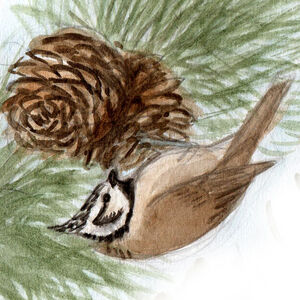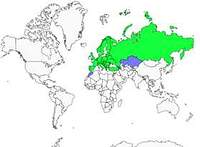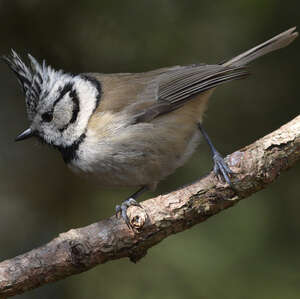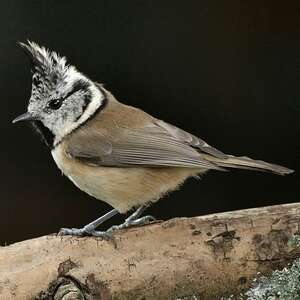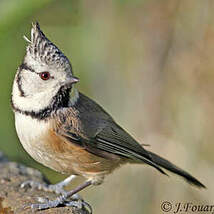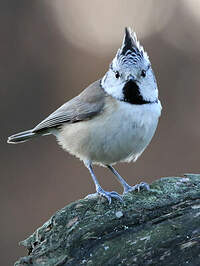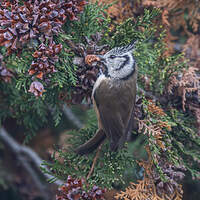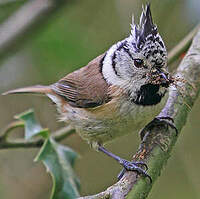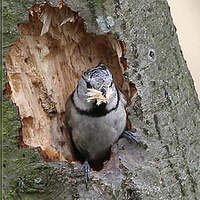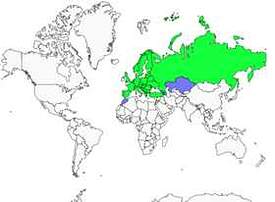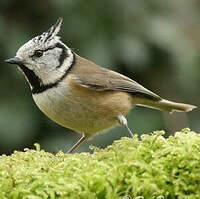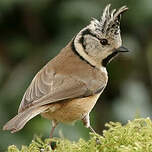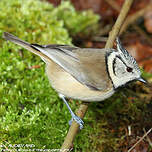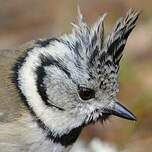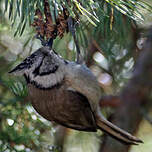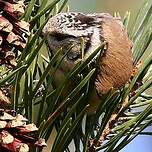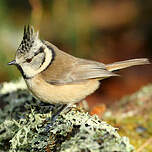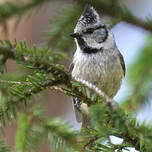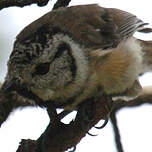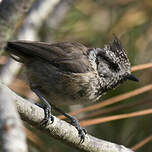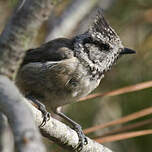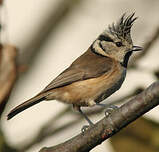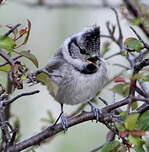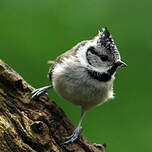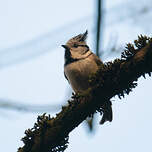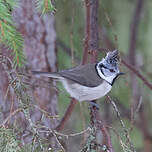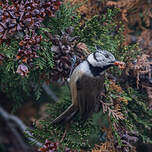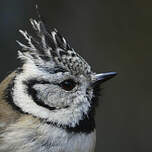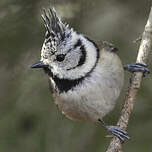Crested Tit
Lophophanes cristatus - Mésange huppée
Identification
The Crested Tit is easily recognisable amongst all the other European small passerines with its pointed crest, speckled with black, white and grey. The rest of the head is also these shades, with a black cheek stripe, extending laterally to a thin black collar reaching up the neck, and a black arc around each ear. The eye is very dark and the beak is black.
The upper parts are brown, quite uniform. The lower parts are tawny with the flanks more coloured. The legs are grey-blue.
There is practically no sexual dimorphism and the juveniles are very similar to the adults.
Subspecific information 7 subspecies
- Lophophanes cristatus cristatus (n and e Europe to the Carpathian Mts.)
- Lophophanes cristatus scoticus (nc Scotland)
- Lophophanes cristatus abadiei (w France)
- Lophophanes cristatus weigoldi (w and s Iberian Pen.)
- Lophophanes cristatus baschkirikus (sw and c Ural M ts.)
- Lophophanes cristatus mitratus (c Europe to ne Spain, the Alps and n Balkans)
- Lophophanes cristatus bureschi (Albania to Bulgaria and Greece)
Foreign names
- Mésange huppée,
- Herrerillo capuchino,
- chapim-de-poupa-europeu,
- Haubenmeise,
- búbos cinege,
- Kuifmees,
- Cincia dal ciuffo,
- tofsmes,
- Toppmeis,
- sýkorka chochlatá,
- sýkora parukářka,
- Topmejse,
- töyhtötiainen,
- mallerenga emplomallada europea,
- Toppmeisa,
- czubatka (europejska),
- cekulzīlīte,
- čopasta sinica,
- Хохлатая синица,
- カンムリガラ,
- 凤头山雀,
- tofsmes,
- 鳳頭山雀,
Voice song and call
The Crested Tit is also easily recognized by its typical rolled calls. This call may consist of up to ten syllables emitted at a high frequency. It has a relatively low tone but is still clearly audible. It is usually preceded by sharp and penetrating single or double sisi. Finally, one may note soft tchip calls, contact calls among a flock.
Habitat
Closely related to conifers, the Crested Tit prefers to inhabit old, compact conifer or mixed stands. Yet, it can also be found in parks and gardens as long as high conifers are present. In Spain, it also frequents cork oak woodlands. It is common throughout France and is even expanding with increasing afforestation of forests.
Behaviour character trait
The Crested Tit is not very wary, but it does not like to show itself openly. At the end of winter, the male parades in flight or raises its crest by vibrating its wings, while the female explores the cavities of the trees or the hollows of the stumps. After reproduction, the Crested Tits join other small woodland birds, tits, Goldcrests and treecreepers in search of food, for the bad season.
The Crested Tit is a sedentary species. Many hardly ever leave their territory.
Dietfeeding habits
Reproduction nesting
For nesting, the Crested Tit makes a hole in rotting wood, even in a single stump. If need be, it can choose to nest in confined places, for example in the tangle of branches of a bird of prey nest, even if it is occupied. The nest is made of moss with a lined base made of hair. The female lays 5 to 8 eggs, mainly in April-May. The incubation lasts 13 to 14 days. The young stay 20 to 22 days in the nest.
Geographic range
The Crested Tit is exclusively European, nesting from the Atlantic front to the Ural at middle latitudes. To the north, it slightly surpasses the Gulf of Bothnia. In Great Britain, it only inhabits Scotland in ancient pine forests. To the south, it reaches as far as the Mediterranean Sea, but it misses most of Italy, only occupying its alpine part in the north, as well as Corsica and Sardinia. In Greece, it does not reach the Peloponnese.
Threats - protection
IUCN conservation status
concern
in the Wild
threatened
evaluated
Sources of information
- IOC World Bird List (v14.2), Gill, F and D Donsker (Eds). 2024-04-18.
Other sources of interest
 Specification sheet created on
28/10/2023 by Didier Collin with help of Georges Olioso
Specification sheet created on
28/10/2023 by Didier Collin with help of Georges Olioso partially rewritten on 00/00/0000 by Jean François
Translation by AI Oiseaux.net
© 1996-2025 Oiseaux.net
- Accipitriformes
- Aegotheliformes
- Anseriformes
- Apodiformes
- Apterygiformes
- Bucerotiformes
- Caprimulgiformes
- Cariamiformes
- Casuariiformes
- Charadriiformes
- Ciconiiformes
- Coliiformes
- Columbiformes
- Coraciiformes
- Cuculiformes
- Eurypygiformes
- Falconiformes
- Galliformes
- Gaviiformes
- Gruiformes
- Leptosomiformes
- Mesitornithiformes
- Musophagiformes
- Nyctibiiformes
- Opisthocomiformes
- Otidiformes
- Passeriformes
- Pelecaniformes
- Phaethontiformes
- Phoenicopteriformes
- Piciformes
- Podargiformes
- Podicipediformes
- Procellariiformes
- Psittaciformes
- Pterocliformes
- Rheiformes
- Sphenisciformes
- Steatornithiformes
- Strigiformes
- Struthioniformes
- Suliformes
- Tinamiformes
- Trogoniformes

